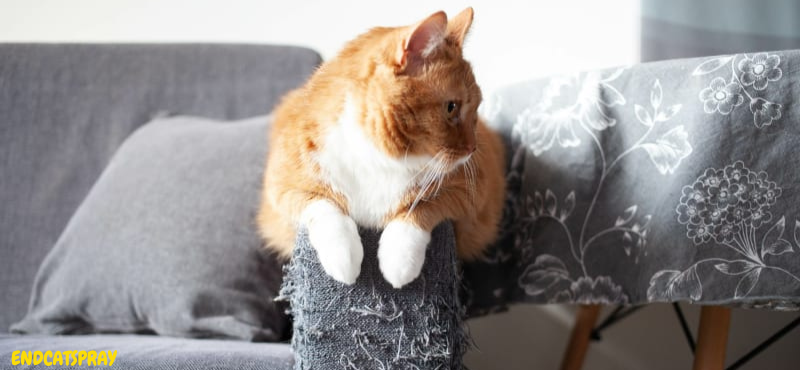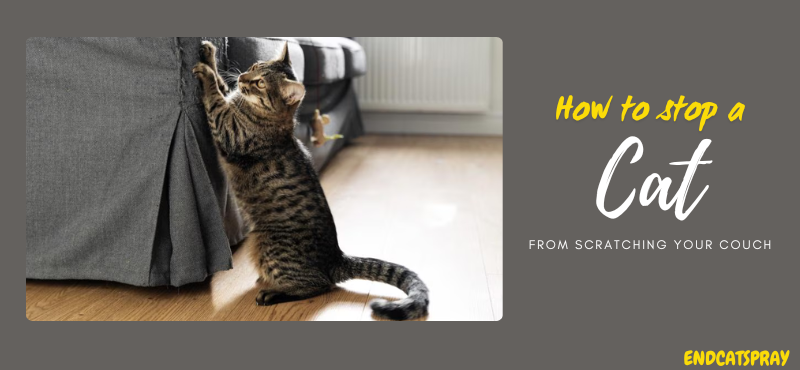Cats love to scratch, it’s in their nature. As important as it is, it can turn out to be quite a nuisance when your favorite couch becomes their usual target. Cats tend to scratch for various reasons. From marking their territory to maintaining healthy claws and stretching muscles, this behavior keeps them happy and healthy. Although, it can leave your furniture looking hideous. The secret to solving this problem lies in understanding why cats scratch and guiding them towards more suitable alternatives.
Why Do Cats Scratch Furniture and Couches?

Scratching in cats can start from a young age of about 8 weeks. This behavior allows cats to mark their territory, leaving both visible signs and scent signals from the glands in their paws. These particular scents carry vital information about the cat whether it’s about its health, sex, or breeding status. Usually, cats prefer vertical surfaces, but materials like wood, leather, and rubber from car tires are also some of their favorites.
How to Stop a Cat from Scratching Your Couches and Other Furniture:
Preventing your cat from ruining your couch takes patience, understanding, and the correct tools. As scratching is the cat’s natural instinct, the aim isn’t to stop it completely but to guide your cat towards a more suitable surface. Here are some ways you can achieve that:
Offer alternatives to scratching:
Provide your cat with appropriate scratching options like scratch posts, boards, or mats, and choose materials like sisal, carpet, or cardboard that the cat finds satisfying. Position these substitutes close to the couch or near your cat’s favorite spot. After the scratching posts are in place, the next step will be to encourage your cat to use the alternatives rather than your favorite furniture.
Keep Your Cat Away from the Furniture:
Spraying the furniture with citrus-based sprays also tends to do the trick as cats dislike such scents. In addition to this, using couch covers as a preventive measure is also a splendid choice.
To avoid all that trouble, simply buying scratch-resistant furniture or scratch posts is also a great investment.
Use Cat-Scratch Tape:
Applying cat-scratch tape on furniture is another great alternative. Putting it over the spots your cat frequently visits makes scratching unappealing to cats as their paws simply run across it.
Use Pheromones:
The best alternative among these is to use special sprays specifically designed for the purpose of preventing cats from scratching furniture. Sprays such as Feliscratch by Feliway are the best for the job as they contain feline facial hormone, a special chemical that cats release upon scrubbing their against objects to mark their territory. By nature, cats are attracted to scratch places where they have rubbed their face. Hence applying the spray to a different location encourages the cat to scratch there.
Clip Your Cat’s Nails:
Tending to your cat’s claws on a daily basis can also reduce the damage done to the furniture. For this, use cat-safe nail clippers and trim carefully so as to not cut too close. If you are hesitant to cut your cat’s claws yourself, then it’s better to turn to a veterinarian or groomer for help.
How to Stop a Cat From Scratching Furniture:

Nature has firmly embedded curiosity and love for scratching within cats and protecting your furniture from the laws of nature can turn out to be quite a challenge. However, with a few well-thought-out schemes, the protection of your furniture and the happiness of your cat can both be ensured.
Buy the Appropriate Scratching Post:
The process can be started with the purchase of two scratch posts, preferably ones that mimic the texture of your cat’s favorite fabric. In that way, it will be less of a risk since you would know that they like it.
This experiment may turn out to be a trial and error among several posts, especially if you have multiple cats. But give each post time before swapping it out.
Position the Scratching Post Thoughtfully:
The next phase of the plan is to place the purchased scratch posts at exactly the right spot in order to make it attractive to the cat such as near a window or the lounge where the family hangs out.
Temporarily Make the Furniture Less Appealing:
Along with making the scratch posts attractive, you must make the furniture appear unattractive to the cat. This can be achieved using vinyl lining as this will encourage the cat to use the scratching post. Even if the cat moves to a different location besides the scratch post, simply repeat the process.
Build Interest in the Scratching Post:
Now that you have made the usual scratching area unattractive, you must make the scratch posts as exciting as possible. Use catnip or the cat’s favorite toys to guide them to the posts. Play with them using a wand tow to lead them to the posts so they feel how good it feels on the claws.
Implement Additional Furniture Protection Measures if Required:
In the case that your cat is still persistent in ruining the furniture, keep on making the furniture look unattractive using the previous methods while also making the scratch post look like a better option. Use the same method until the cat becomes attached to the scratch post.
Enjoy Your Scratch-Less Couch:
Once the cat understands that the couch is not the best place to scratch and the scratching post is a much better option, you are free to remove the countless preventive measures. However, it is to be noted that the preventive measures should be removed one at a time, or else the cat will be happier once it sees its “fun” spot has returned. Make sure that the scratch post is the cat’s favorite spot before removing the protections.
Conclusion:
Stopping your cat from scratching your couch doesn’t mean stopping them from scratching altogether it means guiding them to the right outlets. By providing alternatives like scratching posts, using deterrents, and rewarding positive behavior, you can protect your couch while keeping your cat happy and healthy. With a little patience and consistency, you can maintain a peaceful home where both you and your cat thrive.
Scratching is naturally hardwired in cats. However, stopping them from scratching the furniture should not at all result in stopping them from scratching completely. Provide the cat with suitable alternatives and motivation so that it may use the alternatives rather than your couch. With a little time and consistency, you will be able to nurture the perfect environment where you and your cat can coexist peacefully.










